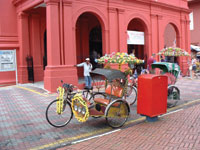Malaysia offers historical marvels

A visit to Malaysia is certainly incomplete, if you have never had a chance to wander through the narrow streets of Melaka (or Melacca) – the state where the idea of Malaysia was born more than 600 years ago.
History has it that an Indonesian king Paramesara arrived at the city in 1402 initiating development to transform it into the Venice of the East.
About 160 km from Kuala Lumpur between the states of Negeri Sembilan and Johor, the city can be reached overland via the North-South Highway from the capital in about two hours.
Over the years, the influx of various civilisations has seen the city developing a multi-racial society consisting of Malays, Chinese, Indians, Babas and Nyonyas, Chittys, Dutch Eurasians and Portuguese Eurasians – each leaving an indelible stamp of their ethnicity and culture on its life and environs.
WHERE TO BEGIN
As you reach the outskirts of Melaka from the North-South Highway and make your way into the city, you will pass Ayer Keroh, some 15 minutes’ drive from the toll plaza. A number of tourist attractions welcome visitors to Melaka there. Perched on a small hill after the toll plaza is Auyin Hill Resort where pagodas and sculptures from ancient Chinese mythology are placed according to the laws of Feng Shui (the Chinese art of geomancy).
Located adjacent to the resort is the Peacock Paradise Bird Park which is home to more than 3,000 free flying birds in an area of 4.5 hectares. Also alongside are the Melaka Zoo and the Crocodile Farm, which is only a 20-minute walk away.
A short drive down the road, the Taman Mini Malaysia theme complex has typical traditional houses of the 13 states in Malaysia. Next to it is the Mini Asean Park boasting a similar concept for visitors wanting to view the houses and cultural elements of Asean countries. Other attractions in the vicinity include a Butterfly Farm, the Ayer Keroh recreational forest and the Museum of Aborigines.
Ayer Keroh has two shopping complexes namely Jaya Jusco and Plaza Kota Mas Tesco – the UK-based hypermarket – located at Peringgit, about 30 minutes drive from Ayer Keroh is another shoppers’ paradise.
IN THE CITY
While Melaka is a lively shoppers’ paradise with all manner of tat everywhere in the city’s narrow lanes and one-way streets, it is best known for its many historical attractions.
Many historical sites are clustered around the Red Square where the buildings are painted red with the 354-year-old Stadthuys Museum Complex as the main focus. The four-storey Stadthuys, situated on a terrace of St Paul’s Hill, was the official residence of the Dutch Governors and is believed to be the oldest Dutch building in South East Asia. Today, it houses the History, Ethnography and Literature Museum, the Admiral Cheng Ho Gallery, the Democratic Government Museum and the Governor’s Museum.
The Red Square has many popular spots for photography such as the Malaysia Youth Museum, St Peter’s Church, Clock Tower and Victoria Fountain in the centre. Atop St Paul’s Hill lay the ruins of St Paul’s Church, which offers a 360-degree view of the city of Melaka.
At the bottom of the same hill is a stone gateway known as A’ Famosa – this is all that remains of a Portuguese fortress constructed in 1511 and later destroyed by the British in the early 19th century. Every night the history of the city is played out in sound and light at the nearby Dataran Pahlawan grandstand.
Among the city’s museums are the Beauty Museum in the People’s Museum where photographs and detailed descriptions of every form of body beautification from around the world are displayed; the Melaka Cultural Museum; the Maritime Museum with a replica of an old Portuguese ship, the Flors De La Mar; and the Baba and Nyonya Heritage Museum, which provides a history of the country’s other ethnic groups. Also worth seeing are the Cheng Hoon Teng and Poh San Teng temples – the two oldest Chinese temples in the country, which date back to the 17th century.
